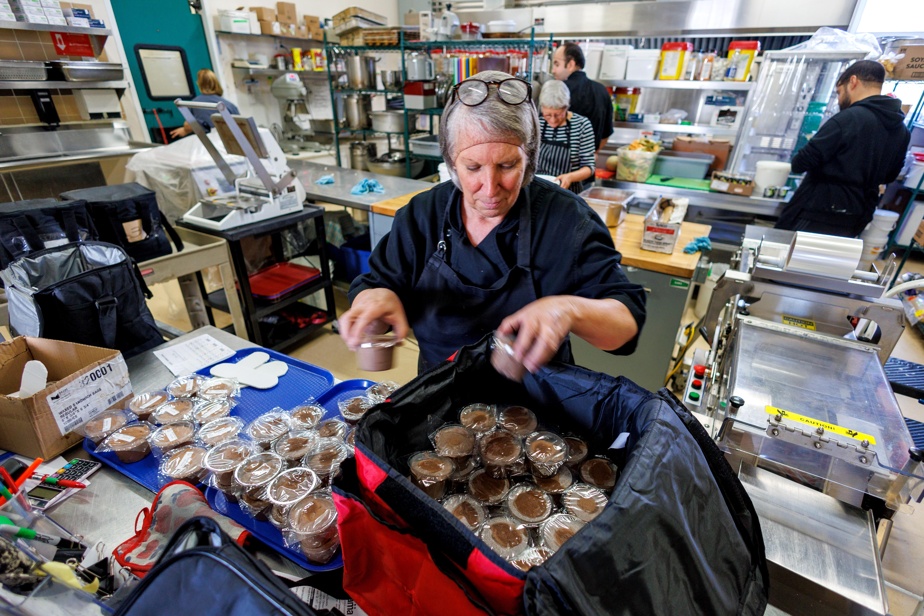
PHOTO ALAIN ROBERGE, THE PRESS
La Cantine pour tous was created in 2016 so that organizations could pool certain resources – financing and business development, in particular. It’s a bit of a federation model, explains Thibaud Liné, general director of La Cantine, where the organizations are members. There are 76 today in a dozen Quebec regions, while there were 14 in 2016.

PHOTO ALAIN ROBERGE, THE PRESS
La Cantine pour tous is a social economy enterprise. Meals are sold, not given away – it’s a model that the company values as it wants to maintain a business relationship with its paying customers. Social pricing allows parents to pay from $1 to $6 for a dish and dessert. Currently, 90% of schools that receive meals through La Cantine are considered to be in disadvantaged areas. The company wants to increase the proportion of schools that are in advantaged environments to reach children who need the service, but who sometimes go under the radar, because they are in a wealthy environment.

PHOTO ALAIN ROBERGE, THE PRESS
Then, in an advantaged environment, the chances are greater that parents will pay the full price for the dish ($6), which will increase the income of La Cantine pour tous. Organizations receive the same amount per dish sold – the more they sell, the more they gain economies of scale, can stabilize their revenues and expand.

PHOTO ALAIN ROBERGE, THE PRESS
At the SCAMA community center in the Chomedey district of Laval, meals are prepared which will then be delivered in an oven container which will keep them hot until the students collect them for dinner. Around a hundred volunteers work at SCAMA. La Cantine carries out quality control in the field, with its partner members. For example, the portions must be adequate – there is also talk of offering “teen” portions for students at the end of primary school.

PHOTO ALAIN ROBERGE, THE PRESS
Arrival at Les Cèdres school in Laval, which has 504 students. Customers made their choices on the La Cantine app from the three dishes offered daily. They also choose the price they will pay. This is the first year that the school has worked with SCAMA and La Cantine pour tous. The service is growing in popularity, management told us.

PHOTO ALAIN ROBERGE, THE PRESS
Once at school, the dishes are distributed to the students by Mme Ginette. In the last year, La Cantine’s clientele has increased from 40 to 106 schools. Some receive meals in bulk, and distribute them as in a traditional cafeteria model; others, in portions. The Canteen must tackle the problem of overpackaging in these cases. Plans are already being explored to adopt reusable dishes, but this will pose handling challenges.

PHOTO ALAIN ROBERGE, THE PRESS
The little ones leave with their meals, hot. Two Laval schools receive meals prepared by SCAMA volunteers, but demand is increasing sharply. One of the challenges is to make it clear to parents that they have access to these meals at the price they can pay for them.

PHOTO ALAIN ROBERGE, THE PRESS
Overall, approximately a third of La Cantine pour tous school clientele pays $1 for the meal, a third pays $3 and the final third pays the suggested price of $6. “The idea is that they pay the maximum of what they can pay,” says Thibaud Liné.

PHOTO ALAIN ROBERGE, THE PRESS
“We want to establish programs in all schools in Quebec,” declares the general director, Thibaud Liné, who is referring to public primary schools. Around 80 schools are on La Cantine’s waiting list, which evaluates potential partners according to the criteria of their strategic objectives: we are particularly interested in the development of less well-served regions, sometimes in rural areas.
Learn more
-
- 24%
- About one in four children (24.3%) lived in households affected by food insecurity in 2022 in Canada.
source: Statistics Canada
